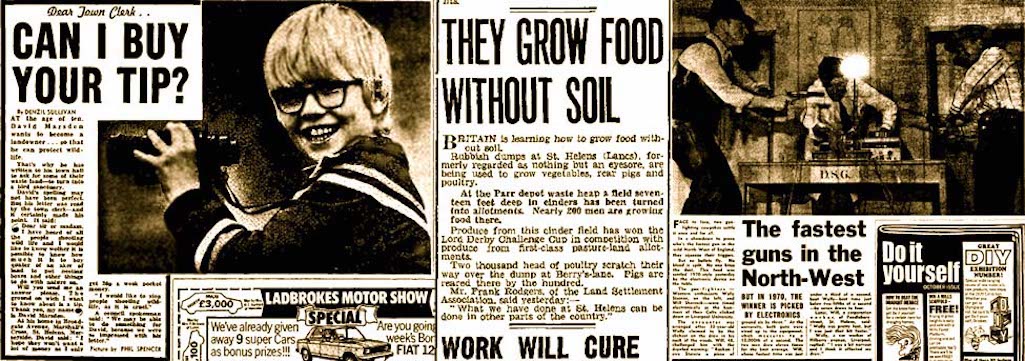An Illustrated History of Old Sutton in St Helens, Lancashire
Part 81 (of 95 parts) - Sutton Trivia & True Facts!
Old Sutton in St Helens
2) The Great Fire of Sutton Moss – For two days in 1899, thousands descended upon Sutton Moss to watch ‘the most extensive and most extraordinary fire which ever occurred at St.Helens’.
3) When Queen Victoria Came Through Sutton – The arrangements for two Royal journey by train when Victoria and her entourage passed through Sutton.
4) Royal and Noble Visits to Ravenhead – Including those made by the Duke of Wellington, Alexandra, the Princess of Wales and Queen Sophie of the Netherlands.
5) The Flying Pharmacist of Junction Lane – The story of Spencer’s chemists who as well as dispensing prescriptions were also aviation pioneers.
6) The Night That 'E.T.' Came To Bold! – In January 1978, Bold Power Station was at the centre of a major UFO mystery when onlookers witnessed its towers being buzzed by a strange, shining light.
7) Frog Frying Tonight in Sutton! – For a while during the 19th century, frog was a Lancastrian delicacy that proved a 'nice little earner' for youngsters in Sutton.
8) Bally Whittaker - The Heavyweight Sutton Builder – John 'Bally' Whittaker was reputed to be the heaviest man in St.Helens. Weighing in at 31 stones, he was referred to as 'Owd Bally' and as a builder was responsible for constructing many notable buildings.
9) The Great Sutton Storm of 1884 – In the space of just ten years at the end of the 19th century, Sutton endured four very severe storms with the one in 1884 the worst, although local builders did very nicely out of it!
10) Dubious Medicines and Sutton Testimonials – Testimonials by people from Sutton and Clock Face during the 19th and 20th centuries for some dodgy medicines.
11) The Day That Sutton Brook Caught Fire! – On Wednesday September 8th 1915 huge flames emanated from the brook near St.Helens Junction, reaching the height of the Bowling Green Inn, which caused great alarm in Sutton.
12) Fred Thomas - The Hermit of New Street – Shortly after WW1, Fred Thomas quit his job on a matter of principle and for decades lived in a shed off New Street by the Sutton vicarage, on land belonging to Sutton farmer Eddie Rimmer.
13) Please Postman, Come Thou Near, and Hark! – In May 21st 1863 an unnamed individual, who was corresponding with Thomas Park of Sutton Rolling Mills, decided to put some style into his letter by writing Park's address on the envelope as a poem.
14) Mickey the Talking Budgerigar – The story of Mary Davies’s budgerigar of Robins Lane, which the Liverpool Evening Express called one of the finest talkers in Lancashire.
15) The Flocks on Sutton Moss – A humorous St Helens Reporter article from 1920 on the hundreds of geese and ducks that lived on Sutton Moss.
Last of the Lamplighters
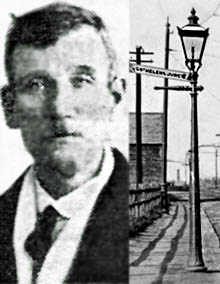
Born c. 1875, John spent 12 years working at Cannington Shaw’s bottle works before becoming a lamplighter in Sutton, charged with lighting and extinguishing each lamp on his ‘beat’. However that wasn’t the extent of John’s work, as during the day the lamps had to be inspected and cleaned, which took about four hours. During his four decades of employment, John witnessed quite a number of improvements. When he first began his job in 1896, the lamp burners had no mantles and there was no such thing as automatic lamps.
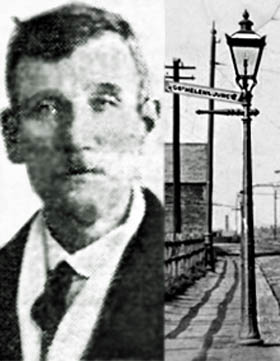
John Maher and a gas lamp in Sutton
During 43 years’ service, John Maher only had 26 weeks off work through illness and for very many years worked every single day of the year. Although in recent times, John had been granted one day off in every fourteen. Apart from being at Sutton, John also at times covered the centre of St Helens and on his last beat before retiring was in charge of 105 lamps. After all those years of walking, he would have been forgiven for wanting to put up his feet and relax. However the lamplighter told a journalist that in his well-earned retirement he was planning to take up walking as a hobby!
John Maher wasn’t exactly the last of the lamplighters. Perhaps the final full-time lighter would be a more accurate description, as one or two others continued the tradition on a part-time basis. This was where gas lamps didn’t have timers, such as by the bridge in Pudding Bag. George Hill, who lived at 28 Woodcock Street, remembers the daily ritual of a lamplighter coming from the Sheeting Sheds to light three such lamps. This was still happening as recently as the 1960s, and George says sometimes, as soon as the lighter was out of sight, he and his young pals would mischievously put the lights out!
The Great Fire of Sutton Moss
For two days during the hot summer of 1899, thousands of people descended upon Sutton Moss to watch what the Liverpool Mercury dubbed 'the most extensive and most extraordinary fire which ever occurred at St Helens'. Smoke from burning turf billowed over Sutton and Parr and train passengers on the adjacent line had a perfect view of the 'prairie fire' as it consumed sixty acres of land. In fact it was believed that a spark from the engine of a passing train had started the fire, setting alight one of many stacks of turf. It was so hot and dry that the fire quickly spread, destroying the work of up to fifty employees of the Lancashire Moss Litter Company.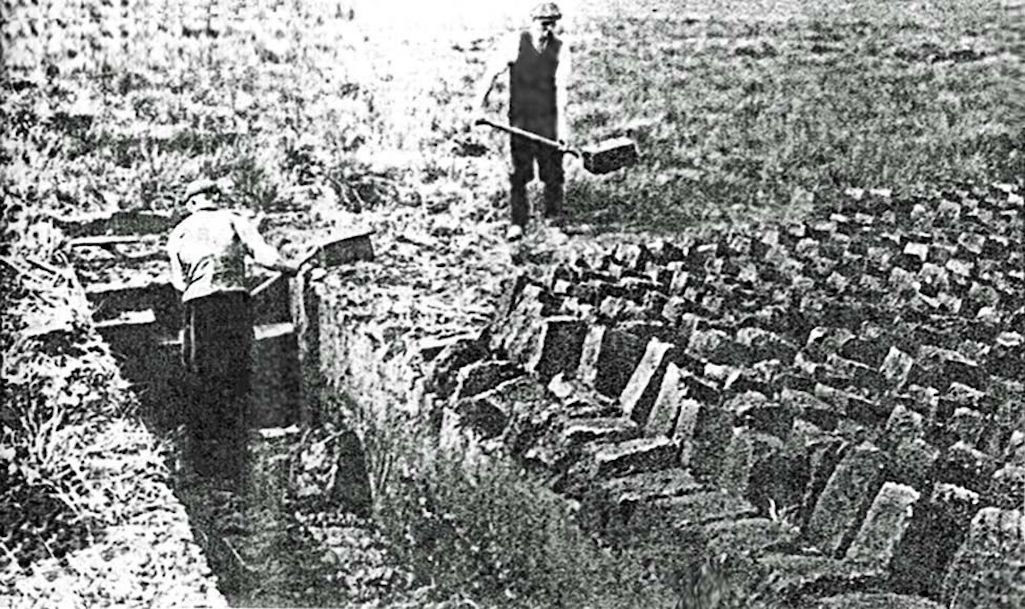
Turf cutters at work at Sutton / Bold Moss - one cuts while the other spreads it out before stacking

Turf cutters at Sutton / Bold Moss - one cuts while the other spreads it out

Turf cutters on Sutton / Bold Moss
Some firelight sellers had arrangements where they could remove the turf themselves. Frank Bamber in his 'Clog Clatters in Old Sutton' recalls Mr. Barrow, the 'Firelight Mon', with his shaggy pony and two-wheeled float. After gathering the cut and dried blocks of peat from the Moss and soaking them in naphtha, he sold them on Sutton's streets as firelighters. Every Saturday morning during the early years of the 20th century, Mr. Barrow would arrive in Edgeworth Street and young Frank would buy a week's supply of 7 firelighters at a penny each. Frank wrote that the 'firelight mon's' hands shone like polished mahogany, through working with peat and naphtha and he had a strong smell of firelighters.
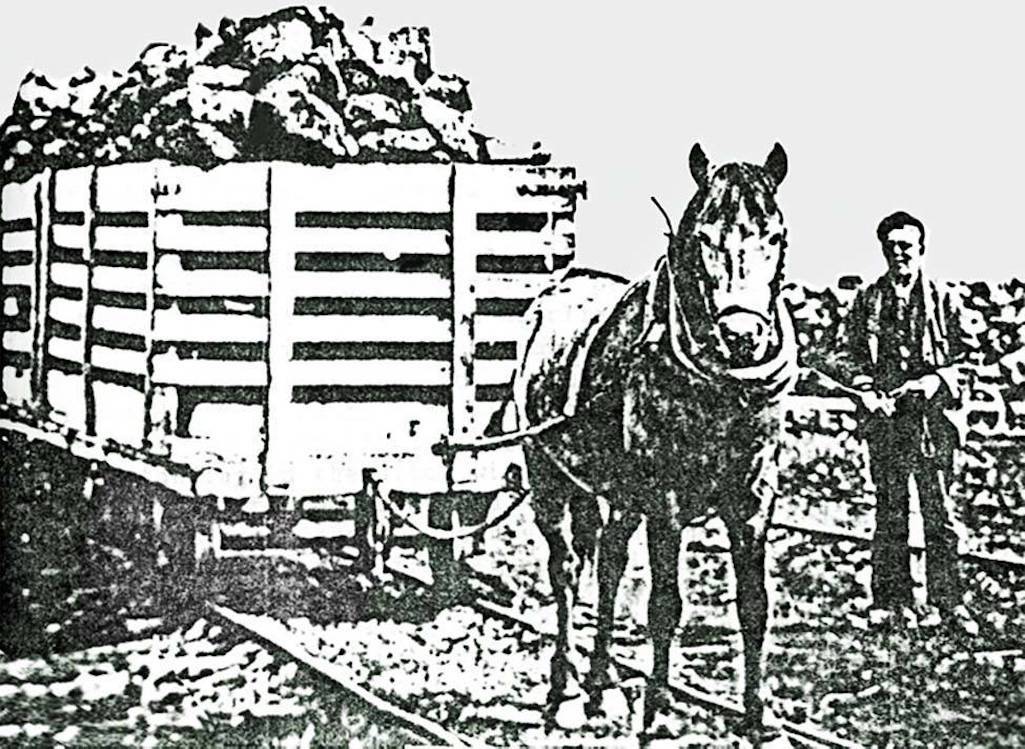
A driver and horse on Sutton Moss with a loaded slatted tram taking the dried peat to a pressing shed

A driver and horse on Sutton Moss with a loaded slatted tram

A driver and horse on Sutton Moss
The fire brigade under Superintendent Lyon eventually arrived from their base at the Town Hall but they had a major problem. Where could they get water from? They settled on a pond at Berry's Lane farm almost half-a-mile away and a couple of hosepipes were put to work. Their priority was to safeguard the machinery sheds where turf pressing and other operations were performed. This they successfully did, although 2500 tons of moss were lost. During the evening, the fire of Sutton Moss was quite a spectacle, as the Liverpool Mercury described:

Left: An old time view of a cutter on the moss; Right: Women sorting and stacking turf at Sutton Moss

Left: A cutter on Sutton Moss; Right: Women sorting and stacking turf
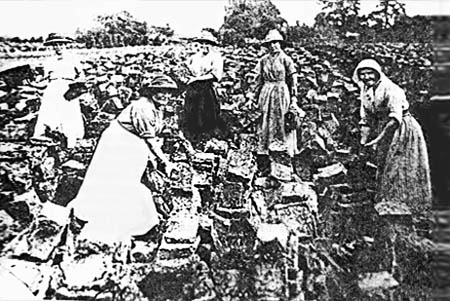
Sorting and stacking turf at Sutton Moss
When Queen Victoria Came Through Sutton
Did you know that Queen Victoria passed through Sutton on two occasions? The first was on Tuesday May 11th 1886 when her special train travelled through St. Helens Junction on a trip from Windsor Castle to Liverpool. The two day visit was mainly to open the city’s International Exhibition of Navigation, Commerce and Industry. The monarch left Windsor just after midnight, accompanied by the Prince and Princess Henry of Battenberg and the Duke of Connaught. Princess Henry was otherwise known as Beatrice and she was the Queen's youngest child. The Duke, a.k.a. Prince Arthur, was her seventh child, and he’d visited St.Helens twelve years earlier on his way to Edinburgh.The London and North-Western Railway provided the engine and twelve carriages, which boasted elegant day and night saloons. The Queen's day saloon had satinwood chairs and couches covered with dark blue watered silk. On the ceiling were four cut-glass oil lamps lined with white silk and a round clock, with a white enamel dial set in a chased gilt mounting, was hung from one side.

The royal party L to R: Duke of Connaught, Princess Beatrice, Prince Henry of Battenberg and Queen Victoria

L to R: Duke of Connaught, Princess Beatrice, Prince Henry & Queen Victoria
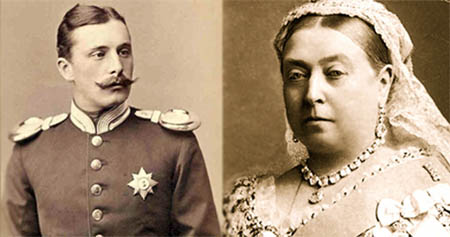
Prince Henry and Queen Victoria
Queen Victoria and the other distinguished visitors remained in Liverpool until the Thursday morning. About 4 to 5,000 people from St.Helens travelled to see the Queen, despite continuous rain and 500 members of the St.Helens 21st Lancashire Rifle Volunteers also attended. The return trip to Windsor steamed through the Junction at 10.22am. Just whether the Queen looked out of her ornate carriage at industrial Sutton and said 'We are not amused', is not, however, recorded!
Victoria never visited St.Helens, despite the town’s strong association with her reign. Victoria Park was originally Cowley Hill Park but it was renamed in 1887 to commemorate the monarch’s golden jubilee. After her death, Sir George Frampton’s statue of Queen Victoria was unveiled in 1905 in the Town Hall Square by the Earl of Derby. In Sutton we have the Victoria pub on Ellamsbridge Road (also known as the Little Pig) and in Gerards Lane there is Victoria Bridge by Monastery Dam and also the demolished Victoria Cottage. Although Queen Victoria never actually set foot in Sutton, members of her family certainly did...
Royal and Noble Visits to Ravenhead
Ravenhead in Sutton was named after Ravenhead Farm, which was originally owned by the sister of the renowned Roman Catholic Bishop George Hay. A number of industrialists were attracted to Ravenhead during the 18th and 19th centuries, although its plate glass works was its main claim to fame. This had been incorporated by an Act of Parliament in 1773 and was the first such works in the country. Over the years a surprising number of royal and military celebrities visited the plant while they were staying with the Earl of Derby at Knowsley Hall. George IV, when he was the Prince of Wales, visited the glassworks in 1826 along with the Duke of Wellington.Four decades later, Alexandra, the Princess of Wales, made a visit to the Ravenhead works. This was on November 1st 1865 and she received a remarkable reception. The Liverpool Mercury said 'Never in the history of St. Helen's has it been recorded that such a concourse of people were assembled together.' A day's holiday was declared in the town and all schools and collieries were closed. Whether the miners on piece-work appreciated losing a day's pay, isn't recorded! The future queen consort to Edward VII was greeted outside the glassworks by 3000 schoolchildren waving flags, handkerchiefs and banners. A military reception was also provided by the 2nd Lancashire Rifle Volunteers (L.R.V.), under the command of Captain Beattie, and the 47th L.R.V., under Colonel David Gamble's command, who presented arms.
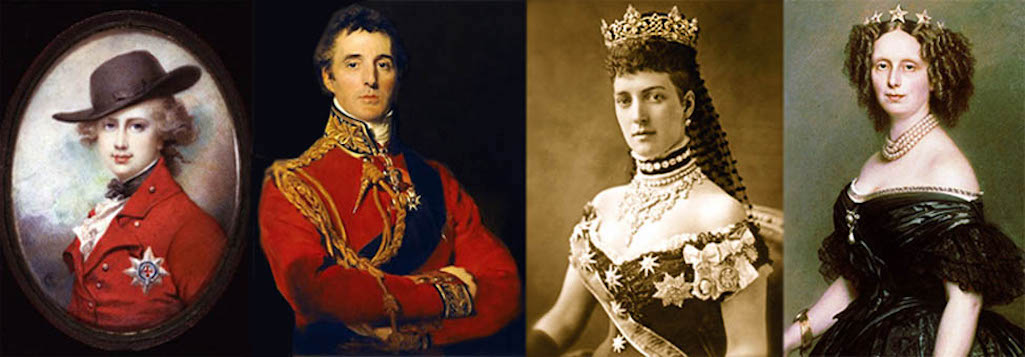
L to R: Prince of Wales (later George IV); Duke of Wellington; Alexandra, Princess of Wales; Sophie, Queen of Holland

L to R: The Prince of Wales (later King George IV); Duke of Wellington; Princess Alexandra and Sophie, Queen of Holland who all visited Ravenhead
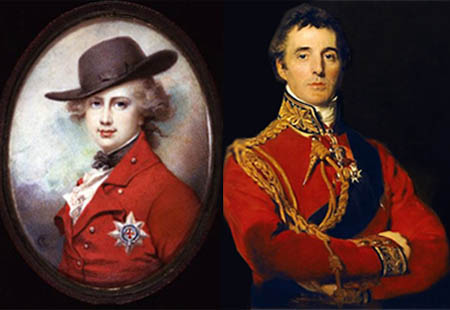
L-R: Prince of Wales (later King George IV) and the Duke of Wellington
They also visited the grinding, polishing and smoothing rooms. In the latter the Mercury described '150 good-looking young women, all dressed alike, in red and white Garibaldi jackets, with linsey woolsey peticoats and white aprons' moving the glass backwards and forwards on benches. Silvering then took place and the Princess silvered some mirror glass herself. The workforce then assembled in the yard and gave the Princess of Wales a 'Lancashire cheer' as she left. Suggestions she also visited the pit sinking of Alexandra Colliery nearby are unfounded, although it did take her name. The Prince of Wales, incidentally, spent the day shooting at Knowsley, where his party killed nearly 800 game.
On September 30th 1867 Queen Sophie of the Netherlands - who was married to King William III - also paid a visit to the plate glass works, where she was welcomed by principal proprietor Sir Edward Sullivan. The Dutch queen was accompanied by Lady Skelmersdale, Colonel Wilson-Patten, Colonel Wilbraham, Sir Robert Gerard and the Bishop of Sodor and Man and schoolchildren lined the carriage drive to the works 'dressed in holiday costume'. Since the visit of the Princess of Wales two years earlier, the long narrow road to the glass firm had been named Alexandra Drive in her honour. Queen Sophie was given similar glassmaking demonstrations to the ones that Princess Alexandra had received, prior to returning to Knowsley Hall. This wasn't the last high-profile visit to the plant as the Prime Minister of New Zealand, Richard Seddon, who was a native of St.Helens, also visited it on August 22nd 1902, although at his request it was somewhat low-key.
Five months earlier on March 12th 1902, a crowd at St.Helens Junction station cheered a royal train as it passed through on its way to Manchester. It was occupied by the Prince and Princess of Wales, who became George V in 1910. Queen Elizabeth II was driven through Sutton Manor on June 21st 1977 and her son Charles visited the Sutton Mill Dam and the Adventure Playground in Gerards Lane on May 24th 1988. You can see photos of these two events here.
The Flying Pharmacist of Junction Lane
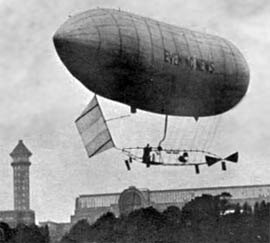
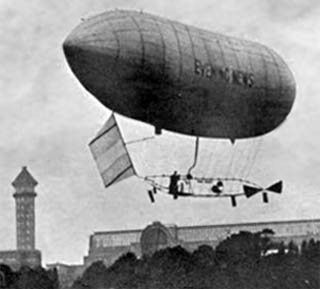
Stanley Spencer’s Airship
Charles had six children including Sydney Ewart Spencer, who was born in Islington on December 12th 1879. All of the Spencer brood became aeronauts although Sydney’s three older brothers, Stanley, Percival and Arthur, were more renowned. Percy is said to have made 1000 ascents and Stanley became the first Englishman to fly in a powered airship over England.
This was a time when ballooning was a highly dangerous activity. The Graphic newspaper of September 1st 1888 commented that: 'The history of ballooning is marked, like the trail of an army, by the dead it has left behind it.' In 1897 Arthur Spencer broke his thigh when he landed on an Australian tombstone and suffered severe injuries in an accident in 1901. His brother Sydney is not reported to have endured any injuries himself, as he seems to have limited his own flying to concentrate on a career as a chemist. However, the archives of the British Science Museum reveal Sydney making test flights in 1904 and in 1911 he was in South Africa experimenting with a balloon on Durban Beach.

The Spencer family memorial in Sutton Parish graveyard at St.Nicholas Church in New Street

Spencer family memorial in Sutton Parish graveyard at St.Nicholas

The Spencer family memorial
During the war, Sydney met his future wife Margaret who was making balloons in the Isle of Man. They moved to Sutton during the 1920s and began their pharmacy in Junction Lane. Sydney died in 1946 but wife Margaret ran the chemist’s shop for fifty years, assisted by her daughter Marie. The family memorial in the Sutton Parish graveyard appropriately bears witness to Sydney’s aeronautical past and his membership of a pioneering family of aviators with ‘balloonist and parachutist’ engraved under his name.
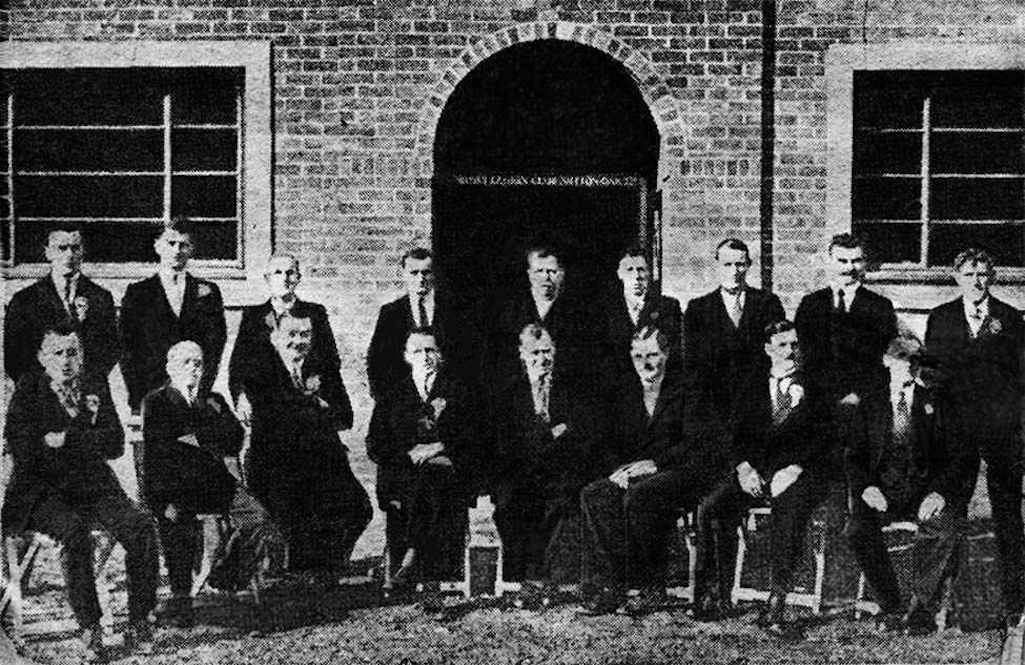
Captain Spencer is 4th from the left on the front row of this 1936 photo outside Sutton's British Legion

Captain Spencer is 4th from left on front row outside Sutton's British Legion

Captain Spencer is fourth from left on the front row of this 1936 photo
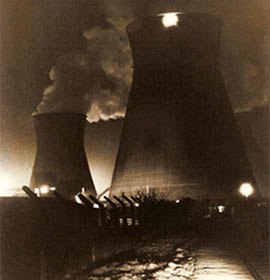

Bold Power Station at night
The story began when amateur radio operator Robert Bennett of Nutgrove received a message from the president of a Liverpool UFO society that unexplained aerial activity had been reported in St Helens. Bennett rang the police and three officers arrived and then sat with him for some five hours, as they and enthusiasts, attempted to track the mysterious object by radio. The 46-year-old listened to the police communications until 3am and was asked to relay messages to the radio hams who were also chasing the craft. Quoted in the St.Helens Star in July 2005 Robert Bennett said:
D.C. Heseltine says that there is still no convincing logical explanation for what happened above Bold and Fiddler's Ferry Power Stations over thirty years ago. However, I like to think that E.T. was simply looking to recharge its extra-terrestrial batteries, so it could return safely back to its home, somewhere within the stars. We shall never really know, of course!
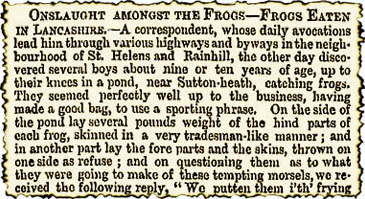

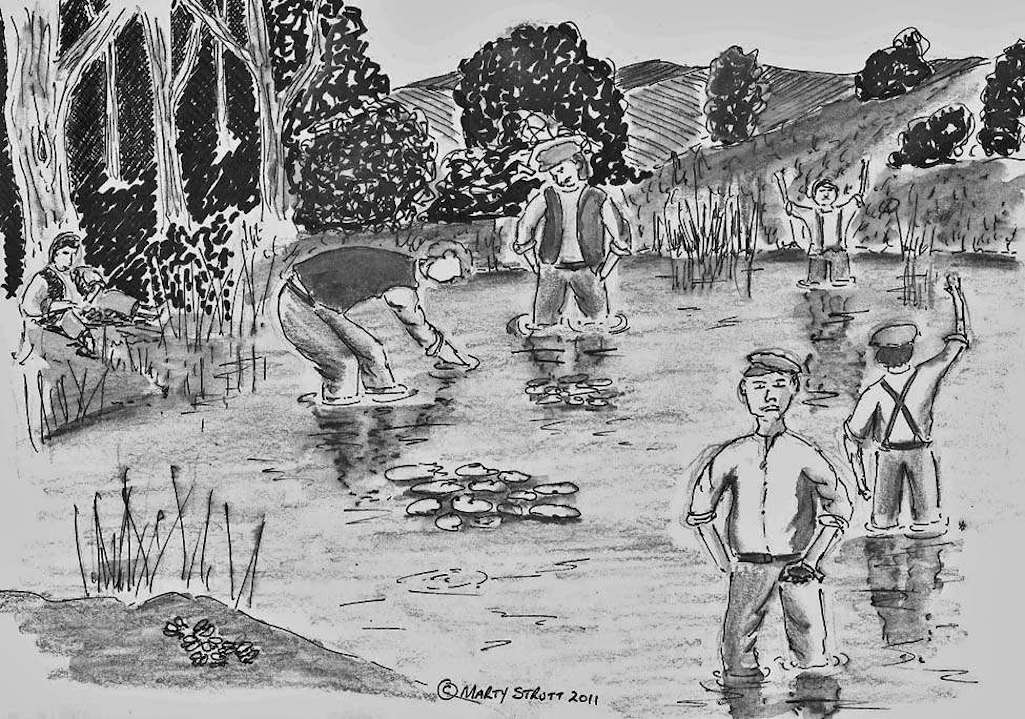
Illustrator Marty Strutt depicts the scene with the lad at the front with frog in hand talking to a reporter on the bank

The scene with the lad at the front with frog in hand talking to a reporter

Marty Strutt depicts the scene
Born in May 1824 in Harpurhey, John Whittaker spent the first thirty years of his life in the Manchester district before moving to St Helens. After serving his time as a bricksetter, he won the contract to extend the Sutton Glassworks for the London and Manchester Plate Glass Company. This launched his career as a builder and contractor and Whittaker soon developed a reputation as an authority on brickwork.
Working out of Foundry Street in St Helens, his company built most of the works' chimneys in St Helens, Garston and Widnes as well as Sutton Road Pumping Station, the Borough Sanatorium at Peasley Cross, Daglish’s Foundry, Neil’s Foundry, the Brown Edge water softening works, Boundary Road Baths, St. Mary’s C.E. School and mission church, Lingholme Hotel, Saddle pub, Pear Tree at Collins Green and the Huntsman at Haydock. For a period during the 1880s Whittaker also ran the Oak Tree Inn at 8 Gerrards Lane. It’s no wonder that whenever he was pressed to stand as a councillor for East Sutton ward, he always replied that he had enough to do to mind his own business!
In later years Bally lived with his wife Ann at Oak Cottage in Neill's Road in Bold, which later became the Neil’s Foundry caretaker’s house. Frank Bamber visited a school friend there around 1920 and was struck by the "extraordinary width" of its doors and frames. The huge stomach of Bally Whittaker meant he had great difficulty in squeezing through average-size house doors, so he had them custom built within his home.
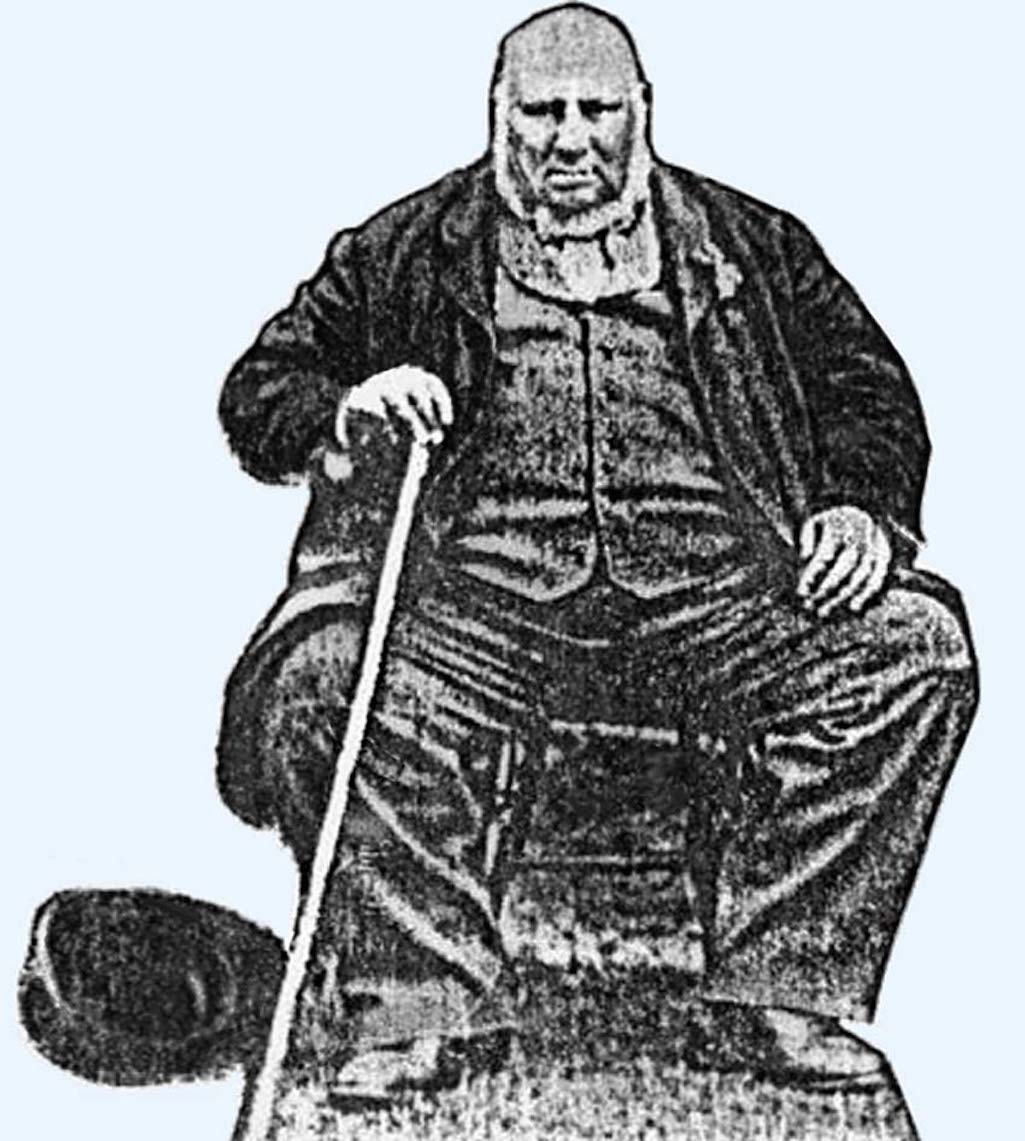
John 'Bally' Whittaker (1824 - 1894) builder and landlord of the Oak Tree Inn in Sutton

John 'Bally' Whittaker builder and landlord of the Oak Tree Inn in Sutton

John 'Bally' Whittaker (1824 - 1894)
John Whittaker was said to have been a jovial character of which there were many stories. For example he learnt that a firm in Liverpool were offering suits made to measure for just 30 shillings, so he sent a man of average size to the shop to order four suits. He told the salesman that one was for himself and the other three were for his brothers. The additional suits were in fact for Whittaker and his two best friends, Joseph Jackson and Charles Rigby. Jackson was a wheelwright and blacksmith of whom Jackson Street was named and who weighed 18 stones. Rigby was a wheelwright from Warrington Road who was also quite a heavyweight at over 16 stones. The shop was initially delighted to receive the order but then shocked to see the tremendous size of the three 'brothers'. Much more cloth would be needed and they were likely to lose money on the deal. However the shop's canny manager spotted a marketing opportunity. So the suits were made at the price quoted and the fame of them subsequently spread to St Helens.
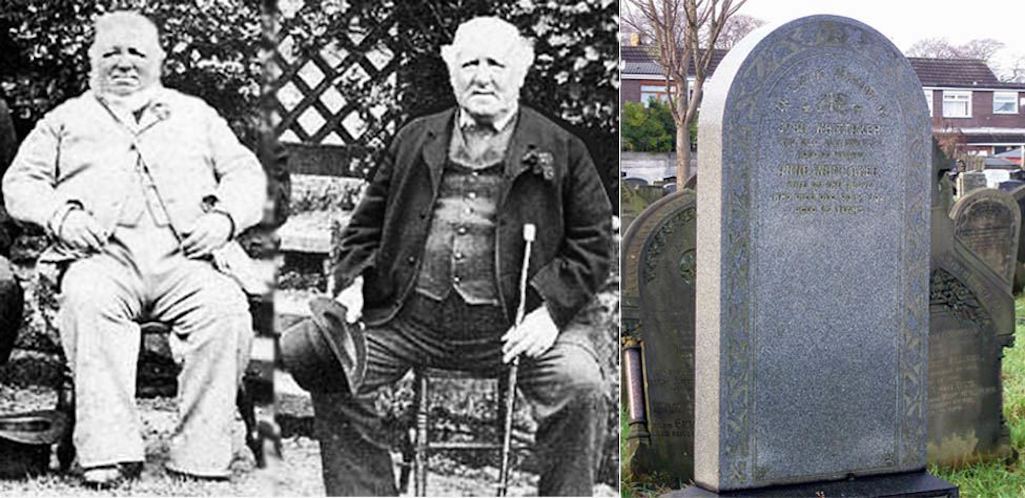
22 stone Joseph Jackson and 18 stone Charles Rigby plus the grave of John Whittaker in Sutton Parish Churchyard

22 stone Joseph Jackson and 18 stone Charles Rigby, plus Whittaker’s grave
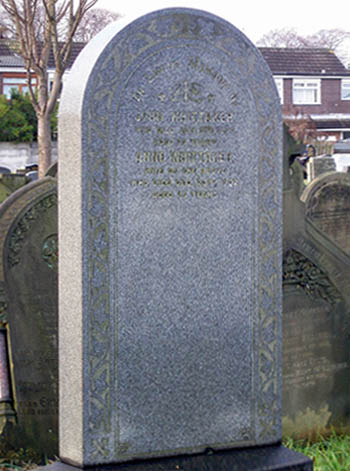
Grave of John 'Bally' Whittaker
Then on November 6th 1890, engineman Thomas Earle was crushed to death at the Ravenhead Glass Works when a 'terrific storm' caused a 130 feet high chimney to blow down on an engine shed. Plus on December 10th 1891, a severe gale caused a chimney stack to crash through the roof of the Red Lion in Robins Lane, giving licensee James Baldwin the fright of his life!
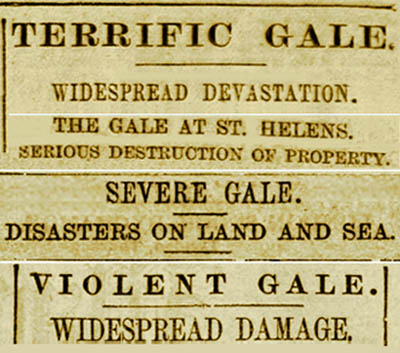
Portions of the roof were carried a considerable distance and huge joists, beams and boards were hurled away by the wind. An 80 feet high works chimney suffered a large crack near its base and was shifted several inches. The cost of the damage at the bonecrushers was estimated at £600, around £30,000 in today’s money.

James Smith ran a grocer's at the end of Blinkhorn's Row and his family of eight were enjoying their tea. Suddenly there was a crash and portions of the ceiling fell on their kitchen table and on the floor. Smith dashed upstairs and discovered that a chimney stack had blown down and crushed in the roof. Inside the bedroom over the kitchen, iron bedsteads had been twisted by the debris. However the furniture and bedding probably saved the family’s lives. They’d broken the fall of the roof and chimney and prevented the bedroom’s ceiling and floor from landing on top of them. As it was no one was hurt, although a pane in the shop’s large plate-glass window was also blown in.
It wasn’t all doom and gloom as local builders did very nicely out of the storm with large numbers of workmen occupied for some weeks. Sutton’s master builder John Fisher had the job of repairing Newton Keates’s chimney and a crowd of locals gathered to watch his men at work. As the proverb goes, it's an ill wind that blows nobody any good!
Plus many working class people were illiterate or couldn't afford to buy newspapers and read his adverts. We will never know whether Dr. Wilkinson's medication was any good but as newspapers became more affordable and literacy levels improved, so unscrupulous folk saw money-making opportunities. Newspapers became packed with advertisements that made wild promises to cure all kinds of ills. There was little regulation of medicines and the advertising of them, so 'quack' practitioners and others making exaggerated claims had quite a field day.
It was soon realised that testimonials by satisfied users would boost sales and quite a few people from the Sutton district - especially Clock Face - were keen to provide them. By the turn of the 20th century, photography and illustrations were employed more extensively in newspapers, so some testimonials were accompanied by the satisfied user's photo.
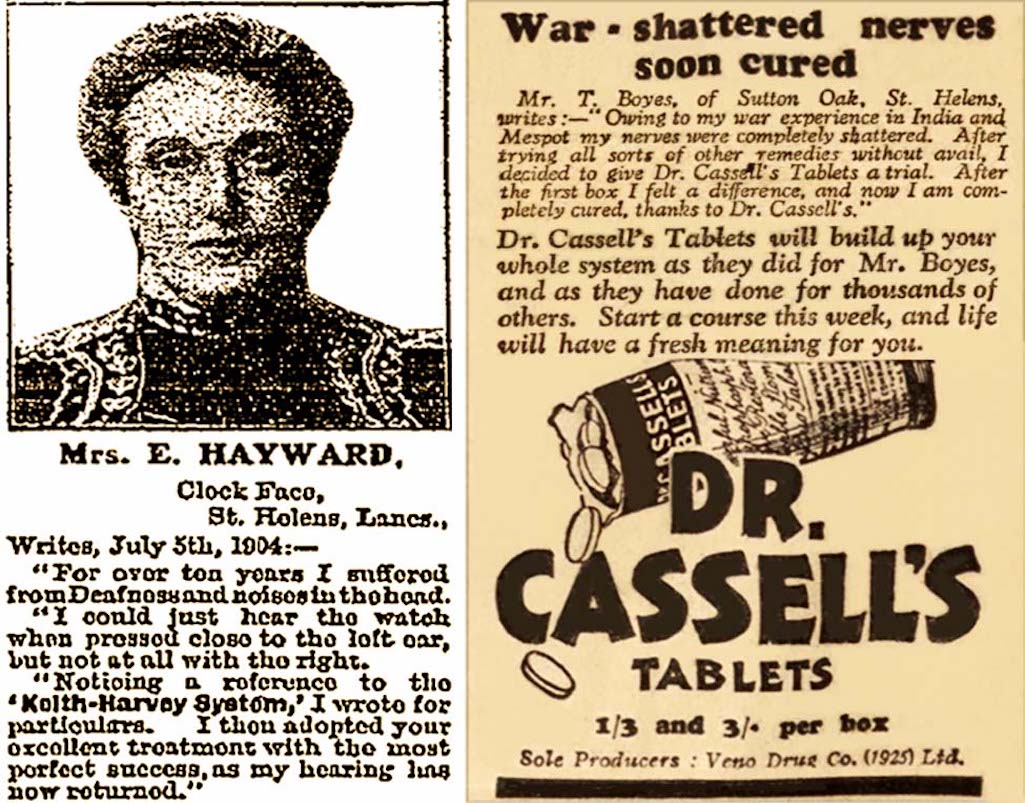
Mrs. Hayward of Clock Face's testimonial from 1905 and Mr. Boyes of Sutton Oak's testimonial from 1927

Mrs. Hayward’s testimonial from 1905 and Mr. Boyes’s testimonial from 1927

Mrs. Hayward’s testimonial from 1905 and Mr. Boyes’s testimonial from 1927
As Dr. Wilkinson was selling nerve medication from Brook House in 1855, so Dr. Cassell was advertising nerve pills on a larger scale in 1927. It's doubtful that there really was such a doctor, but boxes of pills bearing his name were available from 1s 3d each. Mr. T. Boyes of Sutton Oak claimed in newspaper testimonials that they had 'completely cured' his shattered nerves after military service in Mesopotamia and India.
These days newspapers make it clear when articles that they publish are paid adverts. However in December 1910 when Eleanor Thomas from 6 Peckers Hill Road was promoting the benefits of Zam-Buk embrocation, it was presented in the form of an article. The collier's wife told how her three year-old child Katie had benefitted from the ointment, which did seem to have genuine infection-fighting qualities in the days before antibiotics.
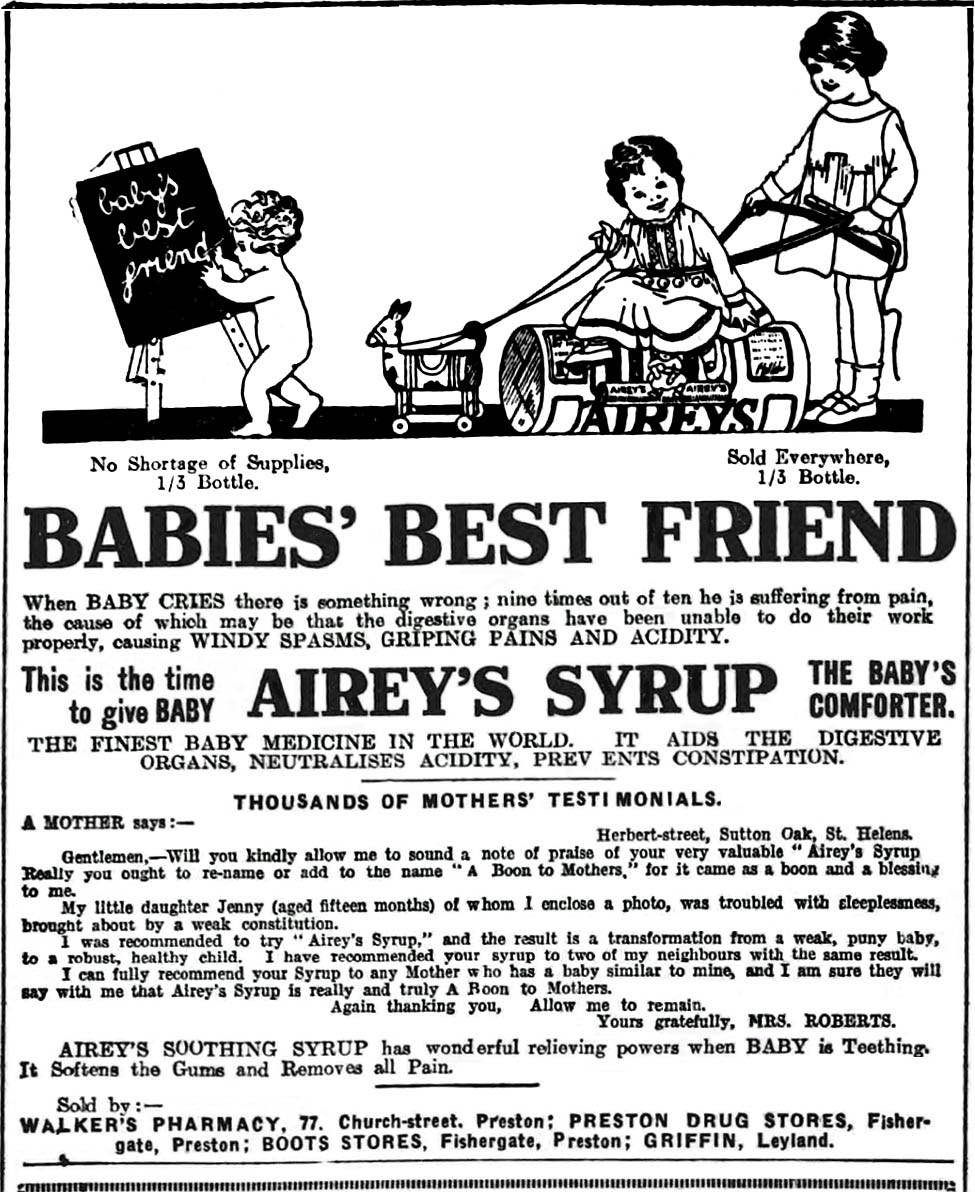
On April 8th 1930, Dr. Williams' Pink Pills were advertised in the Daily Mirror (and in other publications). Under the heading 'When Girls Grow Weak - Beware of Anaemia', it was stated that the 'girl in her teens cannot develop into happy, robust womanhood without abundant blood in her veins'. The pink pills of Dr. Williams were claimed as the answer and a Miss B. Houghton of 2 Crawford Street in Clock Face gave testimony to their efficaciousness. The teenager claimed that she'd been tired and listless with severe pains at the back of her head and had found it difficult to walk. "I cried at the least thing," she wrote.
However taking the pink pills at 3 shillings per box immediately brought about a "wonderful improvement...now I feel stronger than I have ever done". The pink pills had arrived in Britain in 1893 and comprised iron oxide and epsom salts. It's said that they did have some restorative powers but were weaker and much more expensive than standard iron pills.
George Taylor Fulford had bought the rights to the pink pills in 1890 from Dr. William Jackson, paying just $53.01. The Canadian businessman’s massive advertising of the product made him rich and when Fulford died in 1905 he left an estate worth £1.3 million – over £50 million in today’s money.

Advertisement for Apro in The Western Times of Exeter published on Friday 19th April 1940 and Dr. Williams Pink Pills

An advertisement for Apro published in 1940 and Dr. Williams Pink Pills
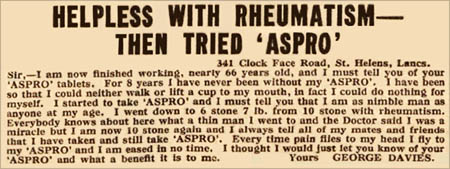
Advertisement for Apro from 1940
Perhaps some of these medicines actually worked for the grateful individuals or maybe it was the placebo effect. In many cases the complaint probably just cured itself as most do in time, but the treatment got the credit. The medication makers, of course, didn't publish the letters that they received from those who said the pills or potions hadn't worked!
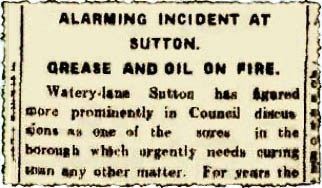
However on Wednesday September 8th 1915 huge flames emanated from the brook near St Helens Junction, reaching the height of the Bowling Green Inn. The St Helens Reporter in their account of the fire described it as causing 'great alarm' in Sutton.

Their minds were, perhaps, concentrated at 6pm that same day, when a man who was lighting a cigarette, threw a match into the brook which ignited the grease and oil on its surface. Flames burst from both ends of the culvert, assistance was summoned and it was only extinguished after large quantities of rubbish was thrown onto the fire. The Reporter said:
Fred kept his unusual place of abode scrupulously clean. He was well educated and refused handouts. Often he could be found in the grounds of St. Nicholas, tidying the churchyard or digging graves to earn cash. Fred also helped out in the fields at harvest time and during winter, dressed in a long, dark coat, cloth cap and wore polished clogs with a white scarf wrapped round his neck. Daily journeys would be made to the churchyard to draw water from a standpipe, accompanied by his dog. Writing on the Sutton Beauty & Heritage Facebook page Val Davies writes: “I remember Fred very well. He was a very tall man with white curly hair, with a flat cap resting on top of his head. He had a friend, Shirty Bertie, who was as short as Fred was tall.”
Bill Bate, now living in Western Australia and author of 'A Sutton Schoolboy's Memories of WW2', remembers Fred from when he was a boy in Sutton:
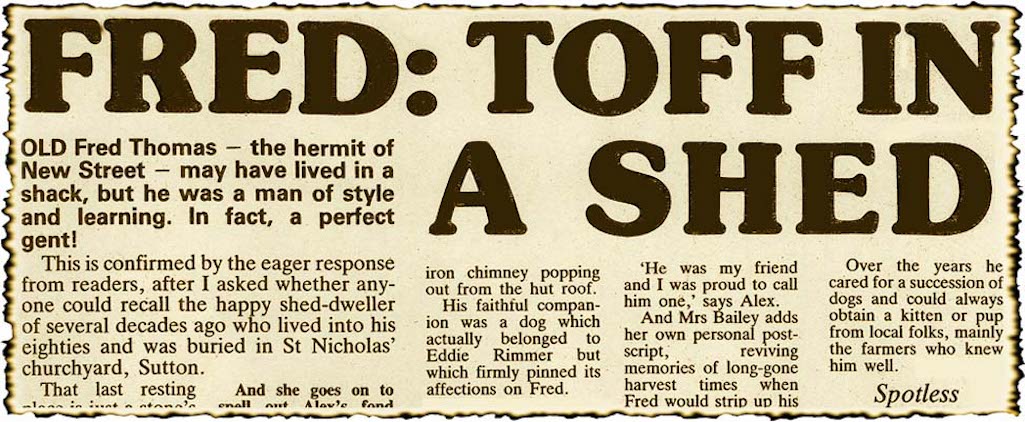
Mickey’s linguistic skills included a number of nursery rhymes and when the bird wanted to leave his cage, he would squawk: “Mickey wants to come out! Put the cat out.” If a stranger produced a cigarette case, Mary’s pet would say: “Does Mother want a cigarette?”, adding: “Mickey wants a cigarette, too”. When ‘Mother’ would go out at night to play whist, the little budgie would cock his head on one side and say: “Good night, good luck.”
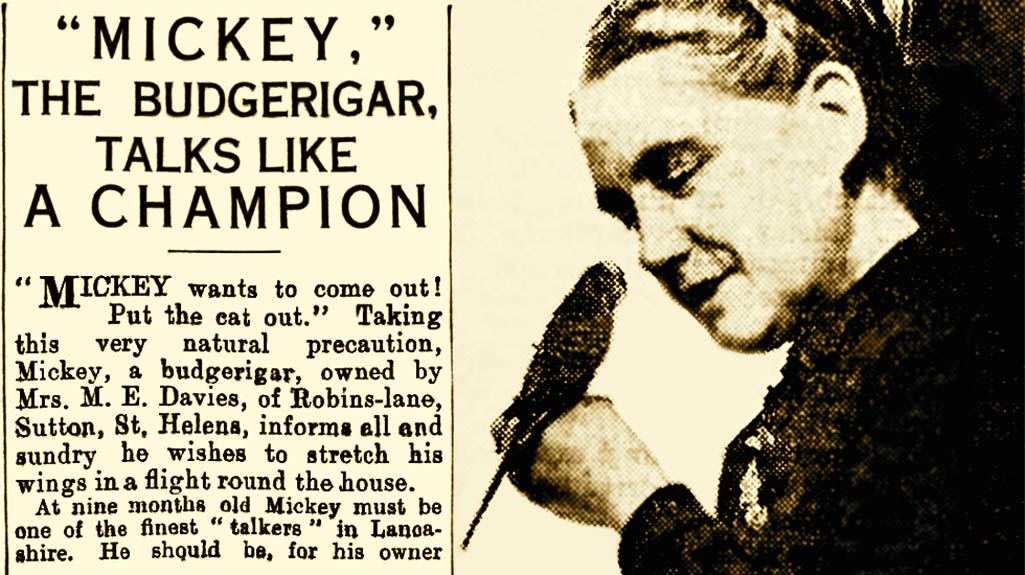
In 1939 there were two persons called Mary E. Davies living in Robins Lane, of not too dissimilar ages. However Mickey’s Mum appears to have lived at number 287, with husband James Davies, who worked at the Sutton Sheeting Sheds.
Sutton Trivia & True Facts in Brief...
Greedy John Brown of Sutton ate himself to death! He belonged to a lodge of Odd-Fellows who on July 28th 1851 held a dinner. Brown had eaten nothing on the previous day in order to enjoy a good 'blow out' at the 'do', which he certainly did. He was reported as having eaten an 'enormous quantity of the good things' and immediately after indulging went into a neighbouring house, sat on a chair and expired. The jury at his inquest ruled that death was through eating to excess. What an odd fellow he truly was!This a true tale of toad in the hole from August 1864 when a miner at Ravenhead colliery called John Elliott hacked off a 9 inch square of coal and discovered a live toad embedded within. It was not possible to extract the poor little thing and Elliott took the coal and toad home and crowds flocked to see it. A man then offered him the huge sum of 10 guineas to buy the piece.
Two lucky tenants from Leonard Street in Sutton received the surprise of their lives in May 1925. Few folk could say they benefited from the scourge of mining subsidence, but these two families did. In 1922 the walls of their houses began to crack and bulge, the floors slanted and the doors became twisted. So their landlord carried out £60 of repairs (about £2000 in today’s money) on the 30-years-old houses, described as ‘roomy cottage’ types. However St.Helens Corporation weren't happy and told him to do more. So the fed-up landlord offered the pair of houses to the Congregational Church to use as prizes in a bazaar. They declined his generous offer, so the weary landlord gave them away to his shocked tenants.
On May 7th 1902 St Helens Town Council discussed improving the post in the Sutton district. The town clerk had mailed a letter to the Post Office about Sutton’s postal facilities more than 18 months earlier but was still waiting for a reply! The clerk told the meeting that the “Postmaster-General’s business must be managed in a very curious fashion.”
On July 10th 1897 Christopher Dingsdale severed an artery in his arm by opening a ginger beer bottle. The glass bottle burst and the 44-years-old's right arm was severely cut. Fortunately he lived in Marshalls Cross Road, near the Cottage Hospital, so was able to quickly get medical help.
Coroner Samuel Brighouse said at an inquest on January 5th 1888 that the appearance of Peter MacDermott was the best joke that he had heard for some time. This was because the beerhouse keeper of 70 Watery Lane had turned up in person to present a note from Sutton's Dr. Edward Casey. This excused the 60-years-old from jury duty claiming he was suffering from bronchitis which prevented him from leaving the house.
The Leyland family grave in St Anne’s cemetery – which includes James Daniel O'Connell Leyland - contain members of one of the oldest Lancashire Catholic families whose lineage dates back to pre-Norman times.
William Ewart Gladstone's wife, Catherine, wrote to Liberals in Sutton on August 19th 1887 thanking them for a gift of a mirror: "Dear Sir. I take up my husband's pen to tell you how much gratified he is at having received so beautiful a present. Will you express to the Liberals of East Sutton his gratitude, and specially for the hearty and most kind good wishes. We consider the mirror beautifully executed, the framework being in excellent taste. I remain, dear sir, yours sincerely, Catherine Gladstone."
Larger than life bottlemaker Samuel Whitfield came a cropper at Cannington Shaw after sitting on a form. The 45-years-old, who weighed 24 stone, was said to have been one of their best workers and arriving early for his shift on June 22nd 1914, he decided to have a smoke. The form he sat on gave way and Whitfield fell backwards down a hole that was ten feet deep. He was severely injured and died in St.Helens Hospital three weeks later.
The Manchester Mercury on January 19th 1790 described how a horse belonging to butcher James Shaw had re-grown two of its feet. The animal was called Old Robin Gray and was being looked after by John Clitheroe, a Sutton watchmaker. It somehow lost both of its forefeet while in the pasture and had to walk on its stumps. The newspaper claimed that some time afterwards, two new feet grew which they described as ‘useful, handsome, and well hoofed’.
On October 9th 1904 there was an almighty explosion in the fireplace of Edward Grace of Peckers Hill Road. Somehow a dynamite cartridge had got in with the coal, and the blast blew out the house's windows and doors. Grace had been sat in front of the fire and was seriously burnt.
A high brick wall surrounding a disused pit shaft near Watery Lane collapsed suddenly on May 29th 1938 leaving a huge gaping hole. The shaft – estimated as 600 feet deep - was used by Bartons Bank Colliery, which hadn’t been worked for 100 years. The area around the old shaft was locally known as the ‘old bank’ or ‘old bonk’. It was thought that the earth round the top of the shaft had been loosened by recent rain and then crumbled away, leaving the brickwork to disappear without trace. The spot was immediately roped off and the police stopped people from approaching the edge.
Little David Marsden was so concerned about protecting wildlife that in October 1978 he sent a letter to St.Helens Council to ask if he could buy some waste ground. The ten-year-old from Broadgate Avenue in Marshalls Cross wrote: "Dear sir or madam, I have heard of all the people shooting wild life and I would like to know wether it is possible to know how much it is to buy quater of an aker of land to put nesting boxes and other things to do with nature on. The ground on wich I want to know about is a tip." As the Daily Mirror commented in its report, David's spelling might not have been perfect but it certainly made an impression with the council. A spokesman said: "We may be able to do something for David, because we were so impressed with his letter". David added: "I hope they won't want a lot of money as I only get 20p a week pocket money. I would like to stop people shooting wildlife, as it is cruel."
When Bill Lynch and his wife and two children moved into Glamis Grove, near Irwin Road, in Sutton in June 1964, they were soon disturbed by strange bubbling and hissing noises coming from their garden. Investigations found that there was an 89% concentration of methane gas coming up through the soil, which covered more than 20 square yards. Both the Gas and Coal Boards wouldn’t help and the family were warned that if the gas seeped into their house, it could cause an explosion.
University students travelled from Manchester, Liverpool and Keele on May 16th 1969 to hold a sit-down protest in Sutton. They were supporting a group of gipsies, who had been given 14 days notice to leave their encampment in Reginald Road. The two week deadline was now up and the travellers had built a barricade to stop bailiffs and the police from evicting them. However the authorities decided not to take any action and so the students went home.
The Roman Catholic Dean of St Helens, the Very Rev. Hugh Fitzpatrick, played a round of miniature golf in Sherdley Park on August 20th 1961 to 'give approval' to St.Helens Council’s decision to allow Sunday sport in the town’s parks. The dean was quoted in the Guardian saying he deplored the protestations of other clergymen, adding that innocent recreation could never be wrong on any day.
Two racist electricians quit their jobs at the UGB bottles factory at Peasley Cross on August 10th 1966, rather than work under a black man. Jamaica-born Eli Erskine had been promoted to foreman, responsible for 15 electricians and labourers who were working on extensions to the factory. Two refused to take orders from Erskine and walked off the site and left for London.
In February 1969 Charlie Moss from Walkers Lane in Sutton Manor nominated four council workmen to the Guinness Book of Records as the slowest garden wall builders on record. He also presented them with a silver cup inscribed: 'World Garden Wall Building Record Holders'. For four months the six feet high, forty yard long wall had been built opposite his home with no sign of completion. Charlie told the Daily Mirror: "The way it's going they'll still be there next August".
Thousands of tons of coal underneath St.Helens Hospital and the nearby Isolation Hospital was purchased by the Ministry of Health in July 1960, but none of it was burnt. The National Coal Board had announced that they were planning to mine the coal beneath the two hospitals, leaving them in danger of sinking from subsidence. So the Government spent £11,000 to buy the coal and prevent it being mined.
David Lamb of Mill Lane suffered a road accident on April 11th 1938 and was taken to St Helens Hospital. The 14-years-old had just been put under anaesthetic for an operation on his ankle, when a power cut plunged the operating theatre into darkness. There was no back up apart from two torches, which the nurses held on their patient. As the operation progressed, the heat became intense, as the electrically-driven fan cooling system had also failed. At the same time a woman was in labour at the hospital and doctors had to work by candlelight for an hour and a half to deliver twins. The story made the front page of the Daily Mirror.
In August 1970 Will Sharrock of Pendlebury Street in Clock Face was named the fastest gun in the North West, but no bullets were fired and no one bit the dust. The 48-year-old Western enthusiast challenged 33-year-old Wally Stainze from Liverpool to a duel to settle a dispute as to who was the best gunfighter. The feud was settled electronically at Liverpool University with both of their Colts wired to equipment that measured to a 10,000th of a second. The two men drew eleven times for the best average and Will, whose fastest time was just under a third of a second, beat Wally by seven draws to four. Some weeks earlier, on June 24th 1970, W. A. Sharrock of Clock Face had a letter published in the Daily Mirror in which he said that his uncle Bill Cannon was a champion clog dancer, who competed against 70 dancers and topped the bill all over the country. He also wrote that his grandfather Robert Sharrock was the only man ever to swim Lake Tahoe in Nevada.
A letter from Mr. H. Smith of 119 Junction Lane, Sutton, was published in the Daily Express on April 9th 1934, which described how he felt to be out of work: "After a period of eighteen months in work I have become unemployed again, but now I see things in a different light. I dare go anywhere for relief. I have not the slightest compunction in living 'on the country'. I go and draw my unemployment pay. I say to myself that a country that cannot find me work has a perfect right to keep me. My wife goes to the clinic and gets free advice and food for our baby. Friends keep him clothed. Once we were independent. We would not take a cent we had not earned. Now we will take anything – free. It is useless to try to keep up a position that is untenable. I keep myself fit by executing some exercises every morning. I keep my mind fit by writing short stories and articles. I long since ceased to worry. This only brings unfitness, and I must be fit when some one wants my services. Besides, I cannot actually starve in England. Exist, yes; but not starve. Good luck and better times will come again, and until they do it is no good worrying. All of us out-of-works must simply keep ourselves fit, in body and mind, try our best, and rely on luck."
On October 7th 1969 Mrs. M. Foster from Leach Lane in Sutton had a letter published in the Daily Mirror's 'Old Codgers' column under the headline 'Tips from a lady milkman'. Mrs. Foster wrote: "Now that the dark mornings are with us again, I would like to make a request to your women readers on behalf of people like me who deliver their daily pinta. When we start work in the half-light it is so frustrating trying to read notes written faintly on tiny scraps of paper. Often these notes fall to the bottom of the bottles, where they stick with the damp and we simply can't get them out, or they disintegrate. The simplest way to leave a note for the milkman is to tear a piece of cardboard from a cigarette or cereal packet and print in one large figure the number of pints required. The cardboard can be jammed into the top of the bottle without fear of falling through and the milkman knows immediately what’s wanted."
Did you hear about St Helens Junction's dancing shed that fell through? Well it never actually got off the ground! A report in the St.Helens Newspaper of May 11th 1886 entitled 'The Dancing Shed at Norman's Lane, Sutton' revealed how a Mrs. Morecroft had attempted to apply for a dancing licence for a shed on behalf of her sick husband. As seven people had turned up to object, the Bench refused to allow an adjournment and Mrs. Morecroft was informed that "the application would fall through". Of course it's quite possible that the application was for people to dance in a shed...rather than for a shed to dance...but who knows!
Sutton has been sent telegrams from the Pope in several years. It happened in 1924 from Pope Pius XI as a result of the Knights of St.Columbia making a pilgrimage to the tomb of Dominic Barberi (1792-1849). He was the Passionist priest who inspired the church, school and monastery at St. Annes and who was beatified by Pope Paul VI in 1963. One local newspaper account reads: 'The following telegram has been received at Sutton from Rome - The Holy Father touched by the homage of the Knights of St.Columbia imparts from his heart the Apostolic Benediction.'!
Not many people know that William Joyce (a.k.a. ‘Lord Haw Haw’) once referred to Sutton in one of his infamous broadcasts. He said that the Nazis were aware of the top-secret chemical warfare plant located off Abbotsfield Road in Sutton Oak. Although ostensibly a chemical defence research centre, for the first six months of World War II, the Magnum plant (as many locals knew it) was the sole manufacturer of mustard gas in the whole country producing 1100 tons (see Sutton at War Poison Gas Works page). Joyce is believed to have visited St Helens about 1938 when the fascist gave a talk in the Corporation Street 'tin chapel'. During the war the chapel was bombed, although there probably wasn't a connection! Joyce was executed for treason on 3rd January 1946 at Wandsworth Prison.
In 1966 the now disgraced Rolf Harris sang of 'Jake the Peg with his extra leg'. To my knowledge no one has ever sung about a cow with extra limbs but Sutton did have one once, albeit briefly, that had seven legs and two tails! A lusus naturae or freak of nature occurs every now and then and in 1872 it happened to a Sutton farmer called Mr. Gavin. The Preston Guardian of June 22nd described the new-born calf of being of 'extraordinary malformation'. The head, shoulders and forelegs were born normal but it had two distinct bodies, each with its own tail and hind legs. In total the cow had five legs at its rear. A lucrative career as a carnival exhibit would, perhaps, have been in store but when farmer Gavin found it, Sutton's own Daisy the Peg was already deceased.
Fred Bennett’s battered attaché case was a big joke to the lads at the North West Brick Company in Sutton Road. Every Friday the 68-year-old wages clerk took it with him to the bank to collect the firm’s pay-roll. But on May 28th 1965 two masked thugs attacked Fred with an iron bar as he was leaving the bank and escaped with the case. However Fred had hid the £400 weekly wages in a money belt under his coat and stuffed old newspapers into his briefcase. Manager Peter Critchley told the Daily Mirror: "We'll never crack another joke about Old Fred's bag. It certainly saved the day."
'When a black chief dies in Africa, red men go into mourning at Peasley Cross, St. Helens'. That was the introduction to an article published in the Daily Mirror on May 13th 1937, under the headline 'They Make the World See Red'. The article was about the Red Oxide Works, which was situated off Peasley Cross Lane, almost directly opposite Alma Place. The piece continued 'The more important the dead man, the longer the sorrow. For during the mourning period the chief's followers cease to decorate themselves with the red colouring matter made in Lancashire, and Peasley Cross villagers are thrown out of work. When busy, Peasley Cross makes the world see red. Every shade and every grade, in every trade for which red is made, is made there, from rouge for women to protective paint for battleships. Its oxides make the workers redder than the reddest of Fenimore Cooper's Indians. Down Peasley Cross-lane, mingling with the red men when the day's work is done, are blue men, in blue clothes from the blue works not far away, black men straight from the colliery higher up the lane, and whiteclad limeworkers, plasterers and bakers'.
“Was it the same cat?”, asked Councillor Nathaniel Birch the Chairman of the Magistrates in St.Helens Police Court on July 14th 1939, adding “it was a very expensive cat”. This was as a result of two cyclists separately charged with riding their bikes without lights who gave identical excuses to the police. William Tickle of 106 Herbert Street had said: “I stopped to see a cat that was killed and was delayed”. Cecil Sterry of 412 Watery Lane had told the bobby who nicked him: “I stopped to see a cat that was killed and removed it from the roadway”. The delay caused by the deceased feline supposedly accounted for them riding their unlit bikes as darkness fell. Their arguments didn’t impress the Bench and they were both fined 10 shillings for the offence.
On October 29th 1859 the Warrington Guardian reprinted an article by H. Syer Cuming for the British Archaeological Association. It concerned a curious medieval vessel in the form of an equestrian knight, which had been excavated in Winwick churchyard c. 1840. The fragment of a very rare earthenware vessel had been used to hold liquid. This was poured in at the head of the rider and distributed through the mouth of the horse. The relic was believed to have been made out of Sutton clay and was described as being of firm texture and reddish in colour.
Agnes Tickle’s mongrel dog was said to be a lovable pet and a friend to children. However the canine, which lived with its mistress at 8 Norman’s Lane in Sutton, had his own pet hate. He couldn’t stand postmen! Having bitten a couple of letter carriers, including John Jones of Sherdley Road who he bit on the leg, the pooch was accused of being a dangerous dog. “We know he is not much good; he is only a mongrel, but we love him.”, pleaded Mrs. Tickle to the magistrates sitting at St.Helens Police Court on November 13th 1939. They considered that the dog was dangerous but decided against a death sentence. However Agnes was warned that another bite on an unsuspecting postie and her dog would be destroyed.
The St Helens Reporter on December 21st 1968 described how 13 children from Sutton Manor had decided to help deprived kids at Christmas. The youngsters got together in early November and first put on a variety concert, which raised a small amount of cash. The children then collected for Guy Fawkes night but chose to save the money. A raffle was their next idea and from the money raised they bought some miniature dolls, which they dressed and then sold. Their final total was £3 5 shillings, which they spent on new toys for needy children. These were supplemented by a collection of second hand toys in good condition and young girls’ dresses. Their gifts had now been passed on to the Corporation’s Children’s Department and would be allocated to the most needy cases in St Helens.
The thoughtful children were Steven Pugh, Julie Byrne, Karen Horan, Linda Pugh, Lynn Barton, Gillian Shorleach, Pauline Duckworth, Sylvia Pugh, Lilian Pugh, Tina Hughes, Pat Duckworth, Ann Gilroy and Janice Hughes.
Bold was the birthplace of Richard Bancroft, who was Archbishop of Canterbury between 1604 and 1610. He was baptised at Farnworth Church, which was built by the Bold family.
On August 29th 1968 the annual Baxters Lane ‘VE Day’ outing to Rhyl took place. The event had first occurred in 1945 to celebrate the end of the European war. The Sutton residents had enjoyed themselves so much that they’d kept the outing going every year since! Neighbours Lilian Litherland and Margaret Lever organised the trip, with collections starting around Easter. The 1968 outing was enjoyed by about 45 children and their mothers and was described as their highlight of the year.
